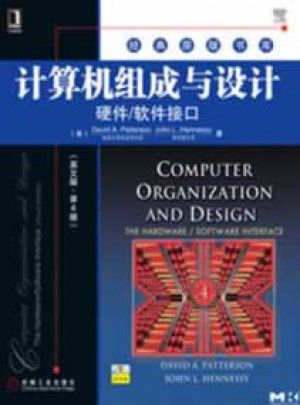
計算機組成與設計:硬件·軟件接口(英文版·第4版)
- 所屬分類:圖書 >計算機/網絡>硬件 外部設備 維修
- 作者:(美)[帕特森],(美)[亨尼斯]
- 產品參數:
- 叢書名:--
- 國際刊號:9787111412373
- 出版社:機械工業出版社
- 出版時間:2013-02
- 印刷時間:2013-02-01
- 版次:1
- 開本:12開
- 頁數:--
- 紙張:膠版紙
- 包裝:平裝
- 套裝:否

《經典原版書庫·計算機組成與設計:硬件·軟件接口(英文版·第4版)》具有以下特色:
涵蓋從串行計算到并行計算的革命性變革,新增了關于并行化的一章,并且每章中還有一些強調并行硬件和軟件主題的小節。
新增一個由NVIDIA的首席科學家和架構主管撰寫的附錄,介紹了現代GPU的出現和重要性,首次詳細描述了這個針對可視計算進行了優化的高度并行化、多線程、多核的處理器。
描述一種度量多核性能的獨特方法-Roofline模型,自帶AMD Opteron X4、Intel Xeon 5000、Sun UltraSPARC T2和IBM Cell的基準測試和分析。
涵蓋一些關于閃存和虛擬機的新內容。
提供了大量富有啟發性的練習題。
將AMD Opteron X4和Intel Nehalem作為貫穿《經典原版書庫·計算機組成與設計:硬件·軟件接口(英文版·第4版)》的實例。
用SPEC CPU2006組件更新了所有處理器性能實例。
這本暢銷的計算機組成書籍經過更新,關注現今發生在計算機體系結構領域的革命性變革:從單處理器發展到多核微處理器,從串行發展到并行。與前幾版一樣,《經典原版書庫·計算機組成與設計:硬件·軟件接口(英文版·第4版)》采用了MIPS處理器來展示計算機硬件技術、匯編語言、計算機算術、流水線、存儲器層次結構以及I/O等基本功能。此外,《經典原版書庫·計算機組成與設計:硬件·軟件接口(英文版·第4版)》還包括一些關于ARM和x86體系結構的介紹。
David A. Patterson,加州大學伯克利分校計算機科學系教授,美國國家工程研究院院士,IEEE和ACM會士,曾因成功的啟發式教育方法被IEEE授予James H.Mulligan,Jr教育獎章。他因為對RISC技 術的貢獻而榮獲1995年IEEE技術成就獎,而在RAID技術方面的成就為他贏得了1999年IEEE Reynold Johnson信息存儲獎。2000年他和John L.Hennessy分享了John von Neumann獎。
John L.Hennessy,斯坦福大學校長,IEEE和ACM會士,美國國家工程研究院院士及美國科學藝術研究院院士。Hennessy教授因為在RISC技術方面做出了突出貢獻而榮獲2001年的Eckert-Mauchly獎章,他也是2001年Seymour Cray計算機工程獎得主,并且和David A.Patterson分享了2000年John von Neumann獎。
1 Computer Abstractions and Technology
1.1 Introduction
1.2 Below Your Program
1.3 Under the Covers
1.4 Performance
1.5 The Power Wall
1.6 The Sea Change: The Switch from Uniprocessors to Multiprocessors
1.7 Real Stuff. Ma:nufacturing and Benchmarking the AMD Opteron X4
1.8 Fallacies and Pitfalls
1.9 Concluding Remarks
1.10 Historical Perspective and Further Reading
1.11 Exercises
2 Instructions:l.anguage of the Computer
2.1 Introduction
2.2 0perations of the Computer Hardware
2.3 0perands of the Computer Hardware
2.4 Signed and Unsigned Numbers
2.5 Representing Instructions in the Computer
2.6 Logical Operations
2.7 Instructions for Making Decisions
2.8 Supporting Procedures in Computer Hardware
2.9 Communicating with People
2.10 MIPS Addressing for 32-Bit Immediates and Addresses
2.11 Parallelism and Instructions: Synchronization
2.12 Translating and Starting a Program
2.13 A C Sort Example to Put It All Together2.14 Arrays versus Pointers
2.15 Advanced Material: Compiling C and Interpreting Java
2.16 Real Stuff:ARM Instructions
2.17 Real Stuff: x86 Instructions
2.18 Fallacies and Pitfalls
2.19 Concluding Remarks
2.20 Historical Perspective and Further Reading
2.21 Exerases
3 Arithmetic for Computers
3.1 Introduction
3.2 Addition and Subtraction
3.3 Multiplication
3.4 Division
3.5 Floating Point
3.6 Parallelism and Computer Arithmetic: Associativity
3.7 Real Stuff: Floating Point in the x86
3.8 Fallacies and Pitfalls
3.9 Concluding Remarks
3.10 Historical Perspective and Further Reading
3.11 Exerases
4 The Processor
4.1 Introduction
4.2 Logic Design Conventions
4.3 Building a Datapath
4.4 A Simple Implementation Scheme
4.5 An Overview of Pipelining
4.6 Pipelined Datapath and Control
4.7 Data Hazards: Forwarding versus Stalling
4.8 Control Hazards
4.9 Exceptions
4.10 Parallelism and Advanced Instruction-Level Parallelism
4.11 Real Stuff the AMD Opteron X4 (Barcelona) Pipeline
4.12 Advanced Topic: an Introduction to Digital Design Using a Hardware Design Language to Describe and Model a Pipeline and More Pipelining Illustrations
4.13 Fallciaes and Pitfalls
4.14 Concluding Remarks
4.15 Historical Perspective and Further Reading
4.16 Exerases
5 Large and Fast: Exploiting Memory Hierarchy
6 Storage and Other I/O Topics
7 Multicores, Multiprocessors, and Clusters
A Graphics and Computing GPUs A-2
B Assemblers, Linkers, and the SPIM Simulator B-2
C The Basics of Loglc Design C-2
D Mapping Control to Hardware D-2
e A Survey of RISC Architectures for Desktop, Server, and Embedded Computers E-2
G Glossary G-1
F Further Reading FR-1